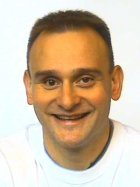Dr. Winfried K. Hensinger
The article Scientists’ “recipe” to help build a quantum computer said
“Quantum technology could be used to crack codes — valuable for national security — and is already used in some bank transactions. Future developments could involve understanding chemical reactions creating medicines, ultra-fast communications systems and seemingly impossible simulations, such as the creation of our universe.Dr. Winfried Hensinger, Lecturer in Atomic Molecular and Optical Physics at the University of Sussex, was part of a team in the USA that has developed a new way of mass-manufacturing ion traps using microchip technology.
Dr. Hensinger says: ‘Making a nano sculpture to trap single atoms and control their motion is very difficult. What we have done is to refine the recipe used in microchip manufacture to make traps for single atoms. Now we could make any kind of trap we need, in the quantity needed. This takes us a step nearer to building the first quantum computer.’”
Dr. Winfried K. Hensinger is Lecturer in Atomic Molecular and Optical Physics at the University of Sussex.
Quantum theory can have powerful applications due to the possibility of implementing new quantum technologies such as the quantum computer. While such a device could have very important commercial and national security applications due to the existence of quantum factoring algorithms, its existence would revolutionize modern day science by allowing true quantum simulations of systems that may be modeled classically only insufficiently due to an in-principle limitation of current computer technology. Recent developments in ion trapping technology show that it should be possible to build a quantum computer with trapped ions.
Winfried’s interest is to develop methods to build such a device. For this purpose his research focuses on applied experimental quantum information science, in particular the development of new scalable methods to build ion trap arrays and the entanglement generation with multiple quantum bits. A second complementary research direction is the exploration of quantum phenomena and their connection to our “classical” world. One key interest is the interaction of atomic and condensed matter systems in the quantum domain. His previous research focused on quantum nonlinear dynamics and quantum chaos with cold atoms. Cold atoms and Bose-Einstein condensates may be used to explore the quantum-classical transition. During time spent at NIST in Gaithersburg he demonstrated dynamical tunnelling with a Bose-Einstein condensate. Another area of interest consists of innovations in tertiary education, in particular, to make learning more effective.
He coauthored Dynamical tunneling of ultra-cold atoms, Ion trap in a Semiconductor Chip, Experimental tests of quantum nonlinear dynamics in atom optics, Scaling and Suppression of Anomalous Quantum Decoherence in Ion Traps, T-junction multi-zone ion trap array for two-dimensional ion shuttling, storage and manipulation, Analysis of dynamical tunnelling experiments with a Bose-Einstein condensate, and authored Pathways to increase problem solving skills, motivation and depth of knowledge in a first year physics course. Read his full list of publications!
Winfried obtained his undergraduate degree (Diplom-Vorpruefung) at the Ruprechts-Karls University in Heidelberg, Germany and then moved to the University of Queensland in Brisbane, Australia where he was awarded his MSc. degree. He continued on and obtained his PhD at the University of Queensland under guidance of Halina Rubinsztein-Dunlop, Norman Heckenberg and Gerard Milburn in the field of experimental nonlinear quantum dynamics with ultracold atoms. During his PhD candidature he spent an extended period at the National Institute of Standards and Technology in Gaithersburg, USA in the group of Nobel Laureate William Phillips demonstrating dynamical tunnelling in a sodium Bose-Einstein condensate. He obtained a Graduate Certificate in Higher Education (Tertiary Education) at the University of Queensland concurrent with his PhD studies restructuring a first year physics course. After completing his PhD he spent three years as a FOCUS Research Fellow in the group of Chris Monroe at the University of Michigan, USA developing ways to scale ion trap quantum information processing, leading into a still ongoing collaboration. In 2005, he moved to the University of Sussex where he heads the Ion Quantum Technology group.
